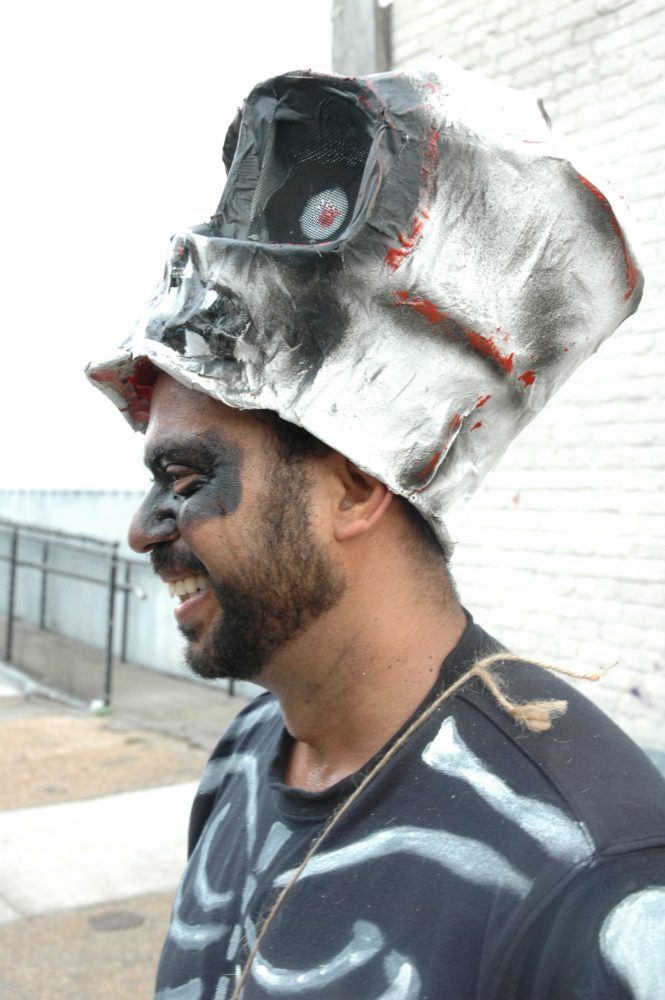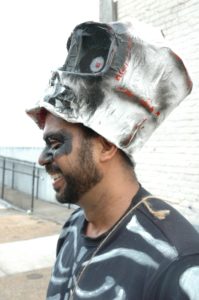Winter 2017
Freedom’s Filmmaker
Remembering Royce Osborn
Published: November 30, 2017
Last Updated: February 21, 2019

Photo by Eric Waters.
Royce Osborn.
First, Ramsey pasted down photos of skeletons, baby dolls, Mardi Gras Indians, and social aid and pleasure clubs. Then, using bright letters that dance across the page, Ramsey entitled the memorial All on a Mardi Gras Day.
“That’s what all the Indians know him by,” Ramsey said. “Skeletons too. And baby dolls and second-liners. Everyone knew him by that beautiful story.”
Osborn, fifty-eight, who died in September at his home in Gentilly after a long battle with lung cancer, had worked in film and television for most of his adult life. He served as head writer of the NAACP Image Awards for Fox Television for twenty-five years and produced several other national shows and webcasts. He made If These Bricks Could Talk, featuring residents of the demolished Lafitte public-housing project; created Spirits of Congo Square; and was working on We Are Zulu, a documentary about the Zulu Social Aid and Pleasure Club.
But Osborn’s page in the book of history is devoted to All on a Mardi Gras Day, the 2003 PBS documentary about black Carnival that he wrote and co-produced with Jerry Brock.
“It awakened a lot of folks, particularly in the black community,” said Xavier University art professor Ron Bechet, sixty-one, a cousin. “We all kind of remembered those things, but we didn’t recognize them as significant until Royce put it on film.”
Though his family later moved to North Carolina and California, Osborn lived until about age ten on Laharpe Street in the Seventh Ward. As children, Osborn and his five siblings, along with cousins David and Gianna Chachere, wore matching Mardi Gras outfits sewn by Osborn’s mother, Paula. They were part of a sprawling black Creole family that included jazz musicians Louis Cottrell and Sidney Bechet. His father, Royce Osborn Sr., was a leading black radiologist and teacher. On the paternal side, an uncle, Aubry Osborn, was the first black priest to attend Notre Dame Seminary. On the maternal side, uncle Gilbert Faustina was one of the founders of the black Catholic lay organization Knights of Peter Claver.
“Royce was always sort of a fighter and a revolutionary and it did run in the family,” Ron Bechet said. “In his film, he showed how Carnival was an opportunity to be free, for the black community to express their freedom.”
“In his film, he showed how Carnival was an opportunity to be free, for the black community to express their freedom.”
He had an acute sense of social justice, said Dama Fountain, Osborn’s wife of seventeen years. “It was instilled. Etched. Ingrained,” she said.
Bedtime listening for Osborn and his brother, Alton, was typically audiocassette tapes of movie thrillers like The Treasure of the Sierra Madre, The Petrified Forest, and Psycho. “Often, we’d be asleep before we had to flip the tape,” Alton said. “But eventually, we could recite every word.”
From early on, Osborn had a fondness for film noir that jibed with some of the darker elements of his hometown, said his close friend and fellow writer Ron Deutsch, sixty-one. “You know, the vibe of a very dark bar with a cigarette hanging out of your mouth, drinking Scotch. Or Robert Mitchum hanging in a bar in Shanghai, waking up in a bar in Mexico City and he doesn’t know how he got there.” Even as Osborn ailed in recent months, he continued to scour TV schedules for film noir movies, which he would watch late into the night with his black cat Oliver on his lap.
Like the Osborns, musician Deacon John Moore, seventy-six, had a front seat for black Carnival because of a childhood spent in the Seventh Ward. “Royce was raised in the palm of the indigenous culture just like I was,” Moore said. “Though I’m a generation older, I saw all of the things he portrayed in the film when I was coming up—the trees on Claiborne, skeletons, baby dolls, Zulu parades, people actually dressing up for Mardi Gras. And I’m really grateful that someone came along and preserved that history for future generations.”
Clarinetist Dr. Michael White, also a Xavier professor, owns a DVD copy of the film. “Still, I watch it every time it comes on channel twelve,” he said. “I can’t tell you how many times I’ve watched it. And each time I watch it I see something different that I missed before.”
“It’s a go-to film,” concurred Michael Crutcher, who wrote the 2010 book Tremé: Race and Place in a New Orleans Neighborhood.
In 2003, the year the film was released, Osborn began masking as a skeleton, first as part of the Northside Skull and Bone Gang, along with Crutcher, and then with his brother Alton as the Congo Square Skull and Bone Gang. Skeleton chief Al Morris taught him how to make distinct papier-mâché skulls, the bloody aprons, and black joggers painted with skeletal bones. Yellow Pocahontas Big Chief Tootie Montana, a former skeleton, made Osborn’s first skull himself.
Soon after the film was first aired, the rebirth of the old traditions began in earnest. “That’s the most valuable thing he did: he exposed these traditions to a new generation, who perpetuated them,” Moore said. Alton Osborn says that his older brother was most in his element as they roamed the streets of the Seventh Ward in the early hours of Mardi Gras morning, hollering, “You Next,” as the older ladies door-popped, with frightened children hiding behind them.
In the skeleton segment of All on a Mardi Gras Day, Osborn’s narration emphasized the tradition’s deeper significance. “Perhaps the most important function of skeletons is to remind us to enjoy life while we can,” he said, in the distinct voice that first explained black Carnival in 2003 and will explain it for generations to come.
Katy Reckdahl is a New Orleans-based news reporter who is a frequent contributor to New Orleans Advocate and Hechinger Report, and has written for The Times-Picayune, The New York Times, National Geographic, The Nation, Next City, and The Christian Science Monitor.
